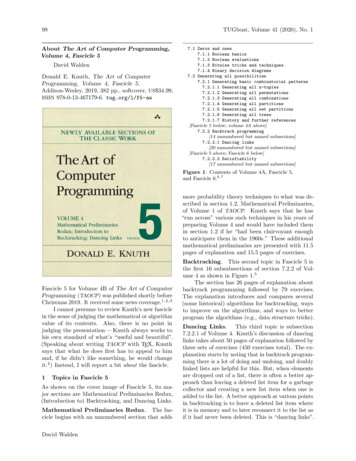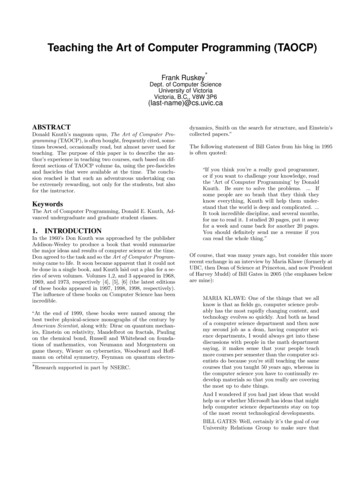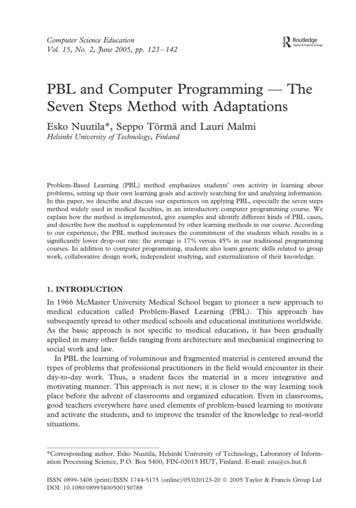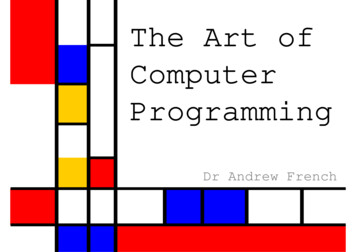
Transcription
THE ACT OF COMPUTER PROGRAMMING IN SCIENCEJAVIER BURRONICollege of Information and Computer SciencesUniversity of Massachusetts AmherstAmherst, MA 01003Abstract. Classically, computers have been used as knowledge discovery tools insofar as theresult of executing a program provides useful insight. For instance, the solution of a differentialequation may help us understand the natural world, the value of a parameter of a statisticalmodel may help us understand the probabilistic structure of a domain, the variable assignmentmaximising an objective function may help to further business goals. A secondary class of knowledge discovery stems from the act of using a programming language. By modeling a domaincomputationally, the developer can discover new and interesting properties of that domain, andbetter convey those insights to others. The purpose of this work is twofold: First, we want toshow that programming languages can help their users achieve knowledge discovery momentsand, secondly, that this property is the least exploited feature of programming languages in thegeneral science community. We want to outline a research program with the objective of makingscientific programming more efficient in its ultimate goal of knowledge discovery.“[. . . ] for Vannevar Bush and for many others, analog machines had a wonderfullyevocative quality. They didn’t just calculate an answer; they invited you to go inand make a tangible model of the world with your own hands, and then they actedout the unfolding reality right before your eyes.” [Waldrop, 2002]1. IntroductionTo computer scientists, the act of transforming an idea into working code is an act of understanding. We assume that this is not because of a particular characteristic of the scientists incomparison to those from other disciplines, but because of the strong relation between our object ofstudy (our domain) and the tools we use, i.e., programming languages. For instance, looking intothe code of an algorithm, a scientist may have a good intuition about the time complexity, memorycomplexity, and even about the correctness of the algorithm. A relevant characteristic is that weget this understanding in addition to the execution of the program. It is the programming languageitself that makes explicit some characteristic of the original problem and allows us to reason aboutit in a different way.E-mail address: jburroni@cs.umass.edu.1Petricek follows Foucault’s concept of episteme. “An episteme defines the assumptions that make human knowledgepossible in a particular epoch. It provides the apparatus for separating what may from what may not be consideredas scientific.” [Petricek, 2016]1
2THE ACT OF COMPUTER PROGRAMMING IN SCIENCEPetricek [2016] discusses the “episteme1, paradigms and research programmes” of programminglanguage (PL) investigation, opening the door for new ways of research in the programming language discipline. The analysis of signs and resemblances in PL appears among the proposed topicsin that work, as one that was hidden in the current episteme. “If resemblances and metaphorsplayed fundamental role in our scientific thinking, we would not just gain interesting insights fromthem, but we would also ask different questions” [Petricek, 2016]. The present work is developedunder the research program proposed by Petricek, but instead of looking at the episteme on whichprogramming language research is inscribed, we focus on the epistemic2 component of the actualprogramming languages: how programming languages aid knowledge discovery. In scientific programming, where knowledge has central relevance, we hypothesise that the capacity of programmingas a device for knowledge discovery is under-used. One important feature of programming languagesthat facilities knowledge discovery is their formal nature, but we leave this property aside to focuson the less explored properties. Our interest lies in knowledge discovery as a result of the act ofprogramming. To this end, we investigate the use of programming languages in science (section 2)examining three different patterns of usage (subsection 2.1, subsection 2.2 and subsection 2.3).Each usage pattern will be depicted with small case studies, and a discussion about names willfollow (section 3). Finally, the need for a theoretical framework to improve the use of programminglanguages in science will be discussed in section 4.We had two objectives when selecting case studies. Some cases were chosen because of theirrelevance to our hypothesis, but others for their relevance to a particular field. In all cases we hopethat they aid in understanding our exposition.2. Programming Languages in ScienceOne scientist is working with data and performs a linear regression. Her results show that the nullhypothesis can be rejected, thus implying the statistical relation between two variables. Anotherscientist is modeling a social-network effect, and she finds that the model resembles a preferentialattachment process. These are two different examples of what we call a knowledge discovery moment,a situation that appears several times during the course of a research based on programming. Thefirst example represents the most common situation that usually happens at the conclusion ofan experiment, when observing the results. Alternatively, the second example represents a moresubtle knowledge discovery moment, a moment that may appear through reflection while creating acomputational model. Notwithstanding their differences, both examples are situations where newinsights are mediated by the use of programming languages. Usually, programming languages areused for calculation —the first example—, but as they are languages, they have features to facilitatereflection and deep thought —the second example. In particular, we have the following underlyingworking hypothesis: an important activity of science, and knowledge discovery in general, is thecreation of concepts, and concepts can be thought as elements of a lower (abstract) level underthe cover of a name. It happens that this activity is also important in programming throughprogramming languages. The relation between both instances of this activity is not fully exploitednor understood. In this section we will explore the different uses of PL in science and how theyrelate to the exploitation of the different knowledge discovery moments. We identify at least threevery different approaches to PL for use in science: a calculation-based approach, an approach basedon domain specific languages (DSLs), and a simulation based approach. This distinction is fuzzy,but it will help us to expose different aspects of programming.2In this work, we follow Turkle and Papert [1990] with regard the use of the word epistemology. Instead of having asingle form of knowledge, the propositional, we build on top of the idea of “different approaches to knowledge”.
THE ACT OF COMPUTER PROGRAMMING IN SCIENCE32.1. Programming Languages as Calculation Devices.“In effect, [J. C. R. Licklider] explained to them, everyone at the Pentagon was stillthinking of computers as giant calculators and data processors.” [Waldrop, 2002]Computers have been used as scientific calculation devices since their creation. Fortran established a way to use the computer that consisted of writing a model, compiling a file and finallyexecuting it. The main knowledge discovery moment stemming from PL designed to do computation is the moment when the result is available, after the execution. In this case, the knowledge iscrystallised in the result. A particular use of these PL that moves away from this paradigm is theexploratory analysis possible when the PL provides a read-eval-print-loop: a REPL. Contemporary examples of this include Mathematica, Jupyter Notebook, RStudio and Matlab. These toolsare useful for both large and small problems. Researchers can readily probe small aspects of thesystem and adapt an experimental plan based on the result of the probes. This is not exploitinga particular feature of a PL (aside from the REPL)—instead it is exploiting the interactive computing paradigm, as devised in the 1950s. The role of interactive computing in the programminglanguage community has changed over time. Smalltalk provides an approach to interactivity thatis completely different to the REPL, as can be seen for instance in Goldberg [1984], but this idea isnot used in mainstream scientific research. Also, Mathematica introduced a way to program in anenvironment that resembles an interactive document, and this idea was followed by Python withits Jupyter Notebook and RStudio. The level of interactivity added to these environments—for instance, with Bokeh [Bokeh Development Team, 2014]—and the enormous progress on performancefor numerical computing put these tools among the favourite options for scientific programming[Shen, 2014]. It is worth mentioning that this idea can be traced back to the WEB environmentdeveloped by Knuth [1984], where LATEX and Pascal code were integrated in a single document.An important difference between the WEB environment and Jupyter is that the former was anexposition of code, a tool to facilitate understanding of the code.2.1.1. Case Study: QuantEcon. “QuantEcon is a NumFOCUS fiscally sponsored project dedicatedto development and documentation of modern open source computational tools for economics,econometrics, and decision making.”3This project made an important step forward in the use of programming for economics. It gathered disparate research in economics, then organized and presented this research to the community.In addition to its quality, the participation of relevant figures as a Nobel laureate attracted theattention of many researchers of the field. Among other things, it created a collection of Jupyternotebooks with a large part of current economic and econometric ideas. A typical notebook fromQuantEcon has the content of a lecture where a specific topic is analysed (see Figure 1). Thesenotebooks usually include very detailed descriptions of a model, consistent with a published article,as in Figure 1a, followed by (or interleaved with) an implementation of the model, as show in Figure 1b. We have reproduced a small functional unit in Figure 2 and a code snippet of this functionis shown in Figure 1c. This code demonstrates a problem that we wish to expose with this work:the task of instructing the computer what to do accounts for the majority of the identifiers. Theseare strictly mechanical operations. In this case, the program is a calculation device, translated frommathematics, and the additions are nuisances required for it to work: identifiers like self , reshapeor slice objects. Our hypothesis is that a theoretical reader will understand this program, in the3http://quantecon.org
4THE ACT OF COMPUTER PROGRAMMING IN SCIENCEsense that the knowledge crystallised by the programmer will be recovered4. However, it is unlikelythat new concepts will emerge from this exposition, leading to a knowledge discovery moment. Webelieve that new concepts will not emerge because it is hard to relate this code to other conceptscreating metaphors and abstractions. We could create suggestions to improve the implementationand even to improve the language. However, we think that it is better to first acknowledge theexistence of a particular problem, then understand its causes and finally propose solutions to it.(a) Screenshot of Aiyagari continuous time’smodel description.(b) Extract of the Household class.(c) Code snippet of method solve bellman.Figure 1. Screenshots of a QuantEcon notebook5. This notebook is based onthe model of Achdou et al. [2014].2.2. Domain Specific Languages. Domain specific languages (DSL), as the name states, containelements proper of their domain while reducing nuisance added by constructs that are only used forgeneral purpose computation. Our main focus are those DSL for which the domain is close to thescientist’s domain. In the previous sections we analysed PL that were meant for computations, and4We use the crystallised information created by Hidalgo [2015]: the code is a crystallised version of the yagari continuoustime.ipynb
THE ACT OF COMPUTER PROGRAMMING IN SCIENCE5some of them are proper DSLs for mathematical calculations. For our purposes, those languagesare not considered DSLs because they are more relevant as calculation tools.The use of domain specific languages yields different knowledge discovery moments. When a DSLis used, we have a knowledge discovery moment which can be related to Kuhn’s view of normalscience: the concepts are already defined in the language and the researcher build on top of theseconcepts. Note that this language may encode an existing paradigm or exhibit an entirely new wayof thinking. However, there is a knowledge discovery moment prior to this, and this happens inthe act of designing a DSL. The challenge is to model the domain’s concept—the basic axioms—interm of the metalanguage, and while doing this task a knowledge discovery moments may emerge.Therefore, the design of DSLs is an interesting moment, and some process like semantic-drivendesign increase their usefulness for the creation of knowledge:“The semantic-driven design process consists of two major parts. The first part isconcerned with the modeling of the semantic domain, which is based onthe identification of basic semantic objects and their relationships. Thesecond part consists of the design of the language’s syntax, which is about findinggood ways of constructing and combining elements of the semantic domain.” [Erwigand Walkingshaw, 2014]It is clear that finding the basic semantic objects and their relationships are fundamental tasks ofscience and while doing this, a knowledge discovery moment emerges. As a downside, this momentis only offered to the designer of the DSL, not to the users. If the designers
THE ACT OF COMPUTER PROGRAMMING IN SCIENCE 3 2.1. Programming Languages as Calculation Devices. \In e ect, [J. C. R. Licklider] explained to them, everyone at the Pentagon was still thinking of computers as giant calculators and data processors." [Waldrop, 2002] Computers have been used as scienti c calculation devices since their creation. Fortran estab- lished a way to use the computer











